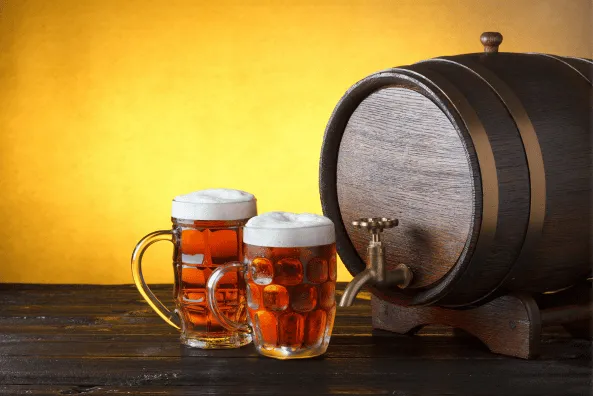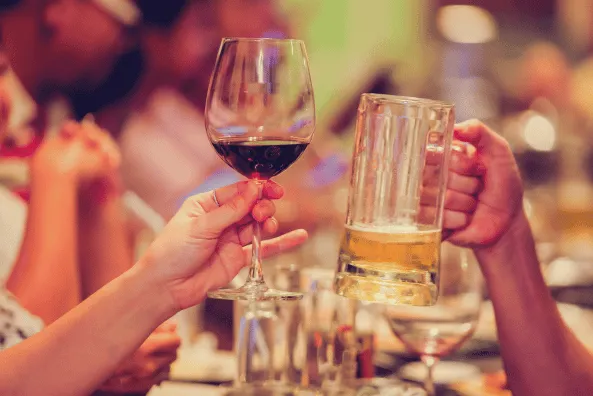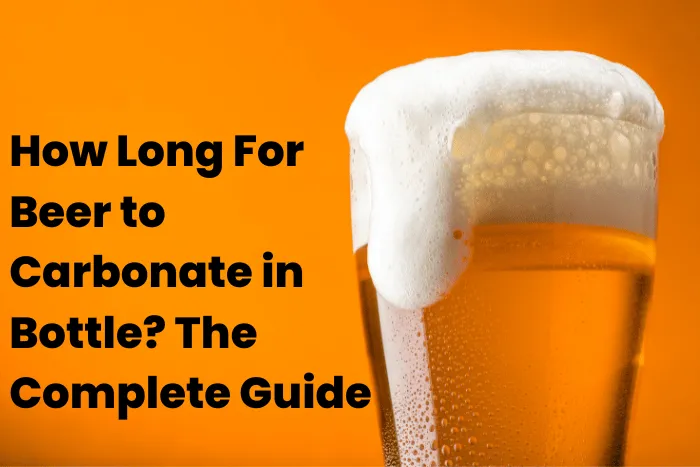Ever wondered how long it takes for beer to carbonate? Achieving the desired level of carbon dioxide in your beer is paramount to its flavor and texture. This post explores different methods for achieving optimal carbon dioxide levels in your brews.
No matter your brewing experience, learning how to carbonate your beer is vital for creating delicious and effervescent brews. We’ll cover everything from force carbonation using a CO2 tank to priming sugar for natural carbonation during bottling day.
We’ll also take a closer look at different beer styles and how their unique characteristics impact the ideal level of carbonation. From crisp lagers to hoppy IPAs, each type requires careful consideration when it comes to determining appropriate levels of CO2.
If you’ve ever experienced a flat beer or over-carbonated brews, you know how important it is to get this step right in the brewing process. By following along with this post, you’ll gain valuable insights into best practices for achieving perfectly balanced and deliciously bubbly beers every time.
Table of Contents:
- The Brewmaking Process
- Carbonation Methods
- Factors Affecting Carbonation Time
- Tips for Bottling Homebrewed Beers
- FAQs about How Long it for Beer to Carbonate in Bottle
- Conclusion
The Brew Making Process

Mashing:
Mashing is the process of steeping grains in hot water to extract sugars. During this step, enzymes are activated, which convert starches into fermentable sugar. The heat and length of mashing affect the kind of beer created, with cooler temps leading to a sweeter brew while higher ones will make it drier.
Boiling:
Boiling helps sanitize the wort (the liquid extracted from mashing) and allows for hop additions which provide bitterness, flavor, and aroma to the finished product. It varies depending on the recipe but typically last between 60-90 minutes.
Fermenting:
After boiling, the cooled wort is transferred to a fermentation vessel where yeast is added to begin fermentation. Yeast consumes sugar during this stage, creating alcohol and carbon dioxide gas, giving the beer its fizziness when bottled or canned. Fermentation can take anywhere from 7-14 days, depending on the style of beer being brewed and environmental conditions, such as temperature control throughout the brewing process.
Conditioning:
Conditioning refers to aging or maturing beer after primary fermentation before bottling/canning occurs. This additional time allows for flavors within the brew to mellow out, giving it more complexity while helping clarify any off flavors that may have been present due to improper sanitation techniques or other issues encountered during the brewing processes.
Homebrewers should allow at least two weeks for conditioning before packaging their beers, although some styles benefit from more extended periods up until several months.
Carbonation Methods:
Carbonation is an integral part of beer-making, and there are two main methods to carbonate your brew – natural carbonation and forced carbonation.
Natural Carbonation:
Natural carbonation involves adding priming sugar or other sources of fermentable sugars to the bottled beer before sealing it with a cap or cork. This method takes time as the yeast slowly consumes the added sugar, producing CO2 gas, which dissolves into a solution and causes pressure buildup inside the bottle. The more you wait, usually for up to two weeks, the more CO2 will be generated, leading to more excellent carbonation when imbibed.
Forced Carbonation:
Forced carbonation requires injecting CO2 gas directly into kegs or bottles using specialized equipment such as gas cylinders or pressure regulators. This method allows for much quicker results than natural carbonation but can be costly depending on how much beer you want to produce at once. With this method, brewers have greater control over their desired level of fizziness by adjusting the levels of CO2 injected into each container they fill.
Carbonation Influence on Flavour and ABV:
The beer type’s alcohol content and flavor complexity can influence the time natural carbonation takes, with lagers typically being quicker than ales. Lighter beers require less time, while heavier ones often need more time due to higher alcohol content slowing down the fermentation processes necessary for successful natural carbonating techniques.
Additionally, lager-style beers are usually easier and faster to naturally carbonate successfully than ales since they generally contain fewer flavors that could interfere with fermentation timescales required for good results from the abovementioned methods.
No matter your chosen technique, patience is key when waiting for your homebrewed beverage to become perfectly bubbly.
Carbonation is a fundamental element of brewing that can significantly influence the taste of beer. With patience, you will be able to carbonate your homebrewed beer with ease. Once you have the patience to carbonate your beer, it’s time to consider factors that will influence its carbonation timeline.
How Long for Beer to Carbonate? Factors Affecting Carbonation Time
Carbonating your homebrewed beer can take varying amounts of time, depending on various elements.
- Lighter beers tend to carbonate more quickly than heavier ones due to their lower alcohol content and higher levels of fermentable sugars. For example, a pale lager usually takes about two weeks for proper carbonation, while an imperial stout may take up to six weeks or longer.
- Lager-style beers are also easier to carbonate as they contain fewer proteins and hop compounds, which can inhibit the yeast’s ability to produce CO2.
- Temperature also plays a vital role in fermentation; warmer temperatures will speed up fermentation and lead to quicker carbonation times, while cooler temperatures will slow down fermentation but may also result in more precise beers with less sediment.
- Additionally, different types of yeasts have varying rates of activity which can affect how long it takes for a beer’s flavors and aromas to develop appropriately before bottling them.
Patience is critical when making homebrewed beer; quality should always come before quantity, whether trying a new recipe or perfecting an old favorite.
Brewers can better plan for and manage their homebrewing projects by understanding the factors that affect carbonation time. Additionally, statistics on bottling homebrewed beers provide insight into which beer styles are easier to carbonate quickly.
Tips for Bottling Homebrewed Beers

First-time homebrewers may find bottling difficult. With advice and perseverance, homebrewing delicious beers is possible. Lagers are easier to carbonate than ales since they have less alcohol and ferment faster. They reach peak carbonation in two weeks or less.
Since yeast consumes less sugar, lighter brews carbonate faster. Patience is vital when bottling homebrew. Rushing this step can result in flat, frothy beers that lack flavor. Thus, bottled beer should be aged at least two weeks before drinking, but three or four weeks is best. Waiting pays off big.
Finally, temperature management is essential when bottling homebrewed beer. Warmer temperatures accelerate fermentation, while cooler temperatures slow it down. Keep bottles cool (65 degrees Fahrenheit) and dark until ready to use for best results. With this advice and data, every homebrewer should feel confident brewing their next batch.
FAQs about How Long It for Beer to Carbonate in Bottle
What is the minimum bottle carbonation time?
The minimum bottle carbonation time for beer depends on the type of beer being brewed and its specific gravity. Generally, lagers necessitate a longer fermentation span than ales, taking between two and four weeks. Ales typically need only one to three weeks of conditioning in the bottle before they are ready to drink.
The higher the original gravity of your brew, the more sugar is available for yeast activity and thus requires a more extended carbonation period. Storing potions at cool temperatures throughout fermentation is vital for producing great-tasting beer with optimal results.
How long does beer need to sit in a bottle?
The readiness of beer for consumption is contingent on its type; lagers and light ales typically need two weeks or more, while stouts and barley wines often require up to six months. Generally, lagers and pale ales require two weeks or more, while stronger beers like stouts and barley wines may need up to six months for optimal flavor. It’s important not to rush this process as allowing the beer enough time in the bottle provides carbonation levels to reach their peak and gives complex flavors more time to develop.
How long does it take to carbonate 5 gallons of beer?
Carbonating 5 gallons of beer typically takes around 2 weeks. The process begins by transferring the fermented beer into a keg or carboy and then adding priming sugar. After this, the mixture must be sealed off from oxygen and left at room temperature for 1-2 weeks until carbonation is achieved.
During this time, pressure builds up in the container due to CO2 being released from the yeast as they feed on sugars in the solution. Once enough pressure has built up; your beer will have been successfully carbonated.
How long does it take to carbonate beer at 20 psi?
Carbonating beer at 20 psi typically takes 7-14 days, depending on the type of beer. The carbonation process begins when the brewer adds priming sugar to the finished and cooled wort before bottling. After adding priming sugar, oxygen is purged from the bottles with CO2 to prevent oxidation.
Keeping sealed bottles at 68°F (20°C) lets yeast feed on residual sugars and produce CO2, naturally carbonating them. During this time, yeast feeds on residual sugars from fermentation and produces CO2, which becomes trapped inside each bottle, creating natural carbonation. Increased pressure or temperature while storage can increase carbonation, which takes 7-14 days.
Conclusion
The laborious process of brewing beer is worth it to enjoy a perfectly carbonated beverage. Anticipating the timing of your favorite brew’s carbonation will assist in attaining a perfect pour when uncapping that chilled beverage. With so many variables affecting timeframes from brew-making to bottling, no two beers are ever exactly alike – which only adds to their charm.
Discover the best ways to carbonate your beer in a bottle with BrewPublik blog. Our blog has everything you need for successful homebrewing, from equipment reviews and subscription services to step-by-step instructions on how long beer takes to carbonate.
Also Visit: Exploring the Differences: India Pale Ale vs American Pale Ale

